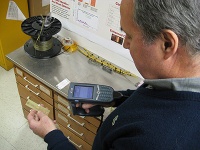Now, research scientists at the Fraunhofer Institute for Photonic Microsystems IPMS in Dresden have developed a microscope head with a diameter of just 8mm that can optically resolve and magnify tissue cells measuring 10 to 20 micrometres.
Fitted in the tip of an endoscope, it can be used for in vivo cancer diagnosis − inserted in the body as in a minimally invasive surgical operation. The scientists envision that the MEMS (micro-electro-mechanical system) microscope head will eliminate the need for biopsies, allowing doctors to perform diagnoses in real time.

’Microscopic image recorders that can be used on endoscopes have not been available up to now. We have developed the first laser-based sensor for this purpose,’ said Dr. Michael Scholles, business unit manager at the IPMS.
’In classic endoscopy using macroscopic imaging, the job can be done by CCD or CMOS image sensors − as used in digital cameras and cellphones. For endomicroscopy, however, MEMS-based image sensors are highly advantageous because they can magnify even the smallest object fields, such as cells, without the need for a large lens. We have combined the sensor with a microscanner mirror to achieve the required resolution of 10 micrometres and can therefore massively magnify the tiniest structures,’ he added.
In use, a laser located in the operating theatre conducts light through a fibre to the microscanner mirror fitted in the tip of the endoscope. This deflects the laser beam and illuminates the tissue. A glass-fibre bundle in the tip of the endoscope collects the reflected light and conducts it to the external sensor, which receives a signal containing the image information. A detector precisely measures the position of the scanner mirror, indicating which area of the scene is being illuminated at the specific point in time. A two-dimensional image can thus be completely reconstructed by combining the position and image-sensor signals.
’In the future, our microscope head will be produced in large quantities in an automated process for subsequent installation in endoscopes,’ said Scholles. He envisages a range of applications for the system − not only could it be used in medical and biological microscopy, but also in technical endoscopy to examine cavities in buildings or to inspect the insides of engines and turbines.





Glasgow trial explores AR cues for autonomous road safety
They've ploughed into a few vulnerable road users in the past. Making that less likely will make it spectacularly easy to stop the traffic for...